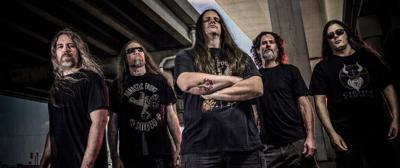
Cannibal Corpse
Last year, the Buffalo, New York, death metal band Cannibal Corpse released its 14th studio album, Red Before Black. It doesn’t vary wildly from the 13 slabs of brutal splatter that preceded it, but it does prove a point: Cannibal Corpse is the quintessence of death metal.
When the band formed in 1988, metal was already moving away from the fantasy and melody of the New Wave of British Heavy Metal (Iron Maiden, Judas Priest, etc.) and L.A. hair metal (Motley Crue, Poison, etc.) into darker territories. Napalm Death was already exploding out of the British scene alongside more anatomically-inspired acts like Carcass. Acts like Repulsion and Autopsy, and, for that matter, Iron Maiden, had already brought the imagery of horror movies and violent true crime into heavy metal. And others, like Bathory and Venom were more explicitly invoking Satan than had previously been heard in their proto-black metal.
Likewise, in Florida, Death and Obituary and Deicide were brewing a humid, heavy style in parallel to Cannibal Corpse. None of them would so fully infiltrate the collective consciousness as the New York icon.
Cannibal’s 1990 debut, Eaten Back to Life, arrived with the band’s aesthetic fully formed. From the group’s name to song titles like “Shredded Humans” and “A Skull Full of Maggots,” the band made its grisly intentions clear. Then, just to make sure, it added a graphic cover illustration of a self-cannibalizing zombie. That morbid and over-the-top violence would permeate the Cannibal Corpse’s album covers, songwriting and merchandise, as it continued to pump out records like Butchered at Birth, Tomb of the Mutilated and Gallery of Suicide through the ’90s.
Naturally, the band elicited more than its share of controversy. Its music was banned in Australia and Germany. Its concerts were canceled in Russia due to “inciting religious division.” And at home, Sen. Bob Dole accused Cannibal Corpse, as well as the Geto Boys and 2 Live Crew, of “undermining the national character of the United States.” Another group of U.S. legislators, including Joe Lieberman, lobbied major labels to remove albums by a list of 20 acts they believed produced the most offensive lyrics. Guess who made the cut.
Emerging at the intersection of the Parents’ Music Resource Center’s crusade against offensive music and the so-called “Satanic Panic” of the 1990s, death metal was an immediately suspicious and maligned genre, and Cannibal Corpse seemed to have a song for every fear. (Songs which the band has regularly defended as works of fiction, akin to violent horror movies.)
Even today, metal fans and critics pen essays reflecting on the graphic, and often sexually violent imagery Cannibal Corpse and other acts have put to tape. Even after 30 years (and even after a markedly diminished reliance on sexual violence in its songwriting), Cannibal Corpse knows how to push buttons.
But it wasn’t taboo alone that drove kids to record shops to hear this stuff in the ’90s, and it still isn’t. Despite appearances, Cannibal Corpse is catchy. Songs like 1992’s “Hammer Smashed Face,” which gained extra exposure from the band’s cameo in Ace Ventura: Pet Detective, have an uncanny sense of rhythm and melodic tension, framing guttural vocals around thick, hooky guitar riffs.
Over the years, Cannibal Corpse has never strayed from its strengths. Later albums like 2006’s Kill, 2014’s A Skeletal Domain and last year’s Red Before Black only refine the elements that make Cannibal Corpse so lasting. Sharp riffs, thunderous low end, cartoonishly extreme gore, and that sly hookiness are only more pronounced on more recent Corpse releases.
As unexpected as that balance of brutality and earworm riffs might seem, for Cannibal Corpse, it’s all part of the plan. Drummer Paul Mazurkiewicz has said of Red Before Black, “Musically I think it’s the rawest sound we’ve had — and at the same time I think it’s our most focused, tightest, and catchiest record.”
Ultimately, Cannibal Corpse’s legacy in broader arenas, where its name is known much more than its music, will likely be haunted by the controversies they’ve courted. Among diehards, though, it will be as it ever was: all about the riffs.







